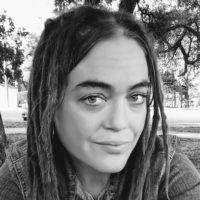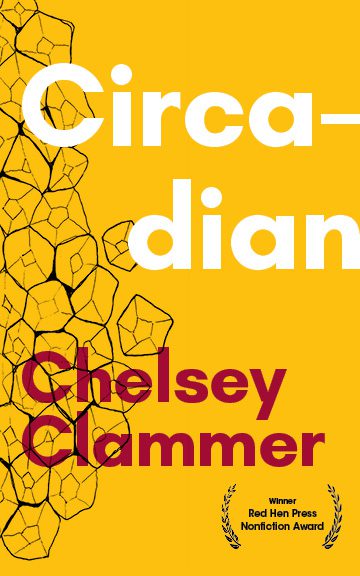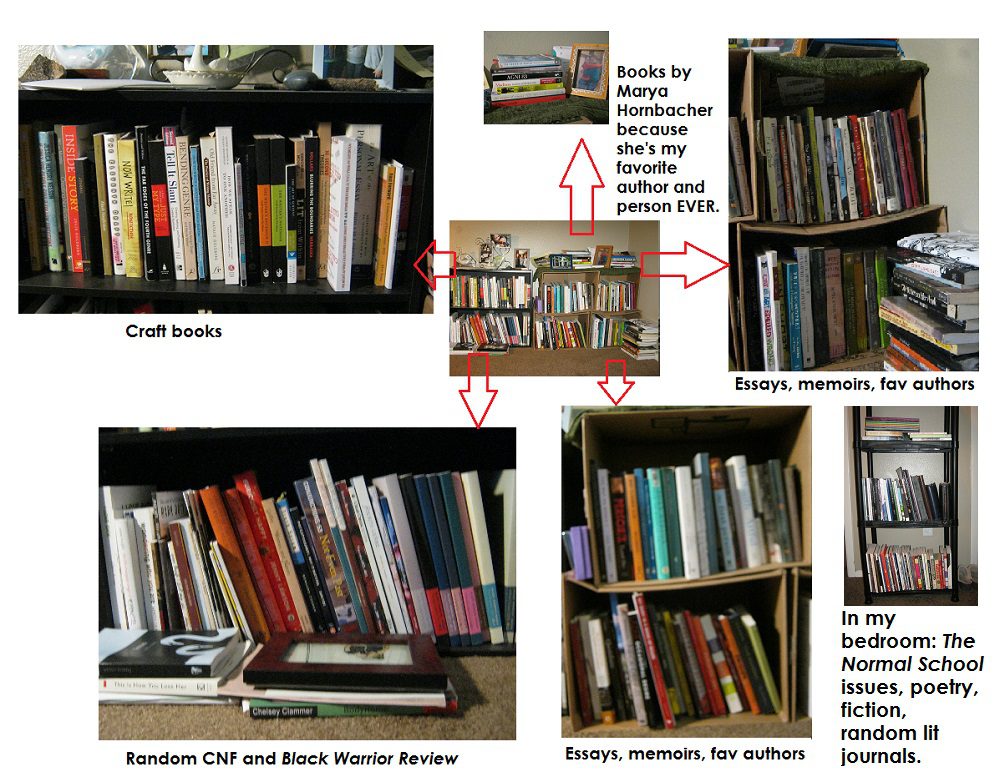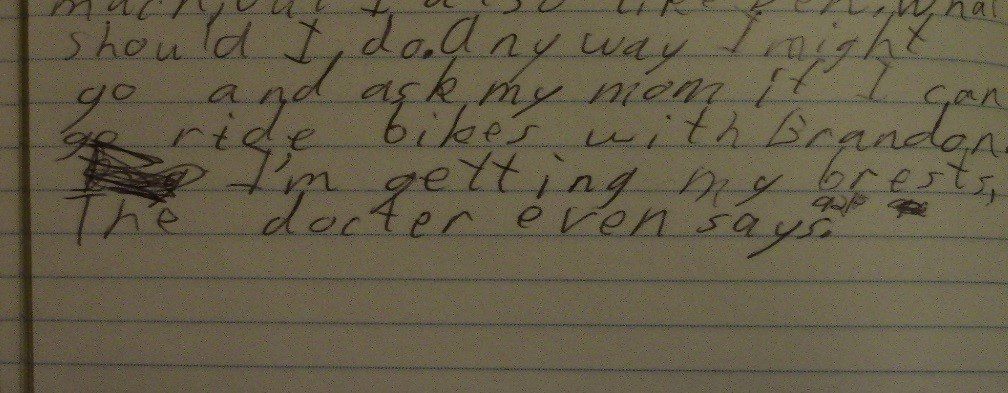Ask a random person what their idea of an essayist is, and they’ll likely describe someone rigid, dull, probably male—someone as boring as the five-paragraph essays they were forced to write in school. Who they probably won’t imagine is Chelsey Clammer.
Waco-based Clammer, author of a new essay collection, Circadian, and 2015’s BodyHome. The former, winner of The 2015 Red Hen Press Nonfiction Award, is playful and humorous, but at the same time, ambitious and unflinching.
While Clammer appears to be the antithesis of the stodgy essayist caricature (she writes from park picnic tables, has dreadlocks, and prefers tattoos to tweed) her work is proof that today’s essayists are taking risks and breaking all the rules. They are attempting more, doing more, and playing more than ever before. Often experimental in language and form, Circadian is ambitious, unflinching, and delightful in its unexpected humor. Recently, she and I corresponded by email.
***
The Rumpus: Circadian is intriguing, not only lyrically, but also in its form. The prose is not always continuous, but often interjects pleasing experimentations with line breaks, lists, diagrams, and wordplay. You’re playing with form a lot. In “Body of Work,” you write, “language and bodies can be fluid if we encourage them to be so.”
Chelsey Clammer: In the same way that our bodies are valued in terms of whether we fit the social construction of what a “normal” body is and looks like, the mainstream approach to writing is like that, too. Whether it’s the five-paragraph essay (like the essay “Body of Work” is messing around with) or the predictable plots of genre fiction, there are certain ways in our culture that writers are expected to tell a story. Obviously, there are tons of examples where authors are writing against the beginning-middle-end formula, but what I’m really interested in exploring is how we, as human beings, take those expectations of writing and then write against them to show how great storytelling isn’t formulaic, but fluid. Our bodies shift throughout our lives, and our writing will shift throughout our careers. In reality, there is no “right” way to write, just like there is no “right” kind of body to have. We write. We have bodies. This is who we are and when we write/live against the social standards and expectations, we find a true sense of beauty in that exploration, and not just in the end result, but the exploration is a type of beauty on its own.
Rumpus: “Outline for Change” certainly breaks standardized confines. You began the essay with the intention of writing about genetics and your father’s death. In this essay alone, you employ several methodologies: numerology, calculations, geometry, mitosis—even a sentence diagram. What was the evolution of this particular essay?
Clammer: One thing that I really love to do in my writing practice is try out super-weird forms that don’t really make sense or don’t “work” in any sort of narrative way, especially in regard to the hermit crab essay. For that kind of essay, you take a writing form that already exists (like a job application or a grocery list) and use that form to tell your story. I love to push myself to try to write crazy things because even though they usually don’t work that well and become more of a hot mess of my oddball thoughts than anything coherent, they really get my mind to think creatively. When I started this essay back in 2014, my intention was to just write an essay in an outline format. I was intrigued by Ander Monson’s essay, “Outline toward a Theory of the Mine Versus the Mind and the Harvard Outline,” and wanted to try writing an outline essay for myself.
And then shit got crazy. I just started getting all of these ideas and my mind was making really weird associations with things, so I just went for it. I started adding in genetics stuff because I’m a total science nerd, and though I’m not quite sure where the idea for adding in numerology came from, but there it was and so I went with it. I then just wanted to push form all over the place in this essay, and so I tried to be as odd and unconventional as possible because why not?! As I continued to write and revise the essay, though, I saw that the story I was trying to tell—what it was like to have a suicidal, alcoholic father—was one that I experienced as a type of chaos, and that by using the outline structure and all of these already-established methodologies was helping me to feel like I was bringing a sort of order to the chaos. So that’s what the overall theme of it became. Once I understood what I was doing in the essay, I was able to weed out some of the over-the-top crazy stuff and form it into something relatively coherent.
Rumpus: I imagine it’s easy to get lost in an essay if your intention is to go off the rails. How do you self-edit essays that exist outside standardized confines? Do essays ever get away from you?
Clammer: Do essays ever get away from me? Well, let’s just say that at one point, when I was writing an essay titled “Graftology,” I had to create a spreadsheet to keep track of all of my metaphors. As I filled out said spreadsheet, I realized my essay was just getting ridiculous. This has happened to me in a number of essays (both published and unpublished) that my odd brain gets too odd to the point that I’m over-metaphoring everything. Eventually, I’ll start to really struggle with what I’m trying to say and I’ll have to take a step back to really look at the essay. By “look,” I mean assess if there’s an actual point to why I’m using a metaphor or a structure in a certain way. If it’s in there just because I think it’s wackiness is interesting, I usually cut it. Wacky is fun, but if there isn’t a purpose to it, then it’s just annoying/frustrating. I think I do this with all of my essays, actually, regardless of which rails they are on (or not). I take a step back and ask myself/the essay, if there’s a point to why I’m saying something in a certain way.
Rumpus: Are there certain standardized criteria necessary to every essay, or would you say that every essay has its own self-determined parameters?
Clammer: An essay needs to contain at least one word, or maybe even just a punctuation mark. That is my criteria. Like I said, there’s no “right” way to write an essay. You just write an essay and let it become what it wants/needs to become.
Rumpus: Does the methodology you employ on the page manifest in the physical spaces you inhabit? Your desk, your home, your body? Do you employ similar methodologies to all aspects of your life?
Clammer: My life, and my writing, is one huge practice of controlled chaos! I’m actually super-super organized in my personal life. I have to be. Because I do all freelance work, I’m my own boss, which means I have to be the one who rides my own ass to get my shit together, basically. Also, I love working at parks or anywhere that has a picnic table. (And, honestly, that allows smoking. I’m a chain-smoker. So it goes.) Coffee shops, too, of course. But parks are pretty and there are a good number of them where I live that have OUTLETS. Hell. Yes. So, due to my “office” being a park and my “desk” being a picnic table, I now carry my office around with me everywhere I go.
Rumpus: What does Circadian mean to you, and how does it apply to your collection?
Clammer: Honestly, I don’t think I even really knew of the term “circadian” before I started writing the title essay in this collection. Back in 2013 and 2014, when I wrote this collection, I had gotten into the habit of doing a lot of googling and Wikipedia-ing when I was writing different essays. I’d think of one fact that was in an essay I was writing, such as cluster headaches, and wanted to do some research on that “fact” in order to metaphor and lyric essay the hell out of it.
So, as I did some research on cluster headaches, the term “circadian rhythms” came up. It’s the natural twenty-four-hour cycle that our bodies are on—it’s how our bodies know when to sleep. Cluster headaches latch onto that cycle and disturb it, in a way. As I read and wrote more, I saw that a lot of what I was writing about were these cycles in our lives. The different cycles we go through with grief, for instance. I would say trauma, too. How it can affect our lives at different ways in different times. Identity formation is also a forward-cycling process, too, I would say.
In our lives, different themes and stories and experiences circle through them. We grow from each of these cycles, especially when initially those cycles at one point hurt us. For me, the collection is about how we cycle through our lives—both beautifully and destructively.
Rumpus: How did putting together Circadian differ from putting together BodyHome? What would you say are the similarities and differences between the two collections?
Clammer: See Venn Diagram.
Rumpus: What texts informed the essays in Circadian?
Clammer: My totally honest answer that’s not trying to sound bitchy or bring up any attitude or whatever—everything I’ve ever read, on paper, on a screen, between the lines, in the energy in the air of every conversation I can remember having, on a lover’s skin, in the eye contact that feels more intense than a touch, in the subtext of every text I’ve read, and experience I’ve had, and all of the words of every lyric essay I’ve ever read.
I recently moved and had to live out of my car for a little while. Everything I owned had to fit in my 4-door Lexus ES 300, which, by the way, was given to me by a writer client, when the car I had just bought nine days earlier was stolen, and I was therefore carless. (I’m a freelance editor. I don’t make enough money to buy a Lexus. Just wanted to make that clear!) This is why my bookcases are cardboard boxes. It works. I had to give away a lot of books, so this is a really incomplete picture of the specifics.
Most specifically: Bluets by Maggie Nelson, “Strip” by Marya Hornbacher, “The Pain Scale” by Eula Biss, Blurring the Boundaries edited by B.J Hollars, and Bending Genre edited by Margot Singer and Nicole Walker.
Rumpus: From inception to the first time you pen or type, what does your first draft look like?
Clammer: I write everything by hand. Absolutely. Every day, I sit down for at least a half hour and just write and see where it goes. I keep a list in my notebook of words, ideas and phrases I think of, and use that list as a type of “prompt” list to get me going. Then, if I like something I write, I’ll type it up and eventually try to shape it into an essay. From there, I write more, revise, write more, research, revise, etc. So, I don’t really have “first drafts,” per se. Just bits of writing that gather and grow into an essay. Because of this, I usually have a bunch of documents that just have a page or two of writing in them, which is the handwritten stuff typed up.
Eventually, they all go into one document to become whatever essay it’s turning into. And then, yes, because my mind thinks more in fragments than any sort of linear narration, I’ll print the essay out, cut it up by sections, and see if the organization can be changed in a way so that the essay makes its point a bit stronger than it had been doing. Once I’m satisfied with the essay, I’ll usually read it out loud a few times, do some nit-picky shit with commas and em dashes, and then off it goes! I’ll submit it to a dozen places at once and then move on to the next bit of handwritten stuff that feels like it could be an essay.
Rumpus: In previous correspondence, you’ve shared some of your tattoos with me. What does the tattoo mean to you as a written, or drawn expression of yourself?
Clammer: I see my tattoos as different mile markers in my life. All of them at one point held a very significant meaning for me—every single one of them is a symbol for a moment in my life when I was really feeling that a part of my identity needed to be represented on my body. I don’t regret any of them. There are some that I might not get now, but knowing they were important to me at one point keeps me from wishing I hadn’t gotten them. (Though I do have one cover-up tattoo. Word of advice for the heartbroken: wait until you are sober to really think about if you need your heartbreaker’s initials tattooed on the inside of your wrist.)
I feel like my whole body is a text, regardless of words or images tattooed on them. People “read” one another’s body every moment of every day—which is where discrimination and stereotypes stem from. The more positive Chelsey likes to believe that our bodies are also a way to communicate who we are as unique individuals. Having tattoos further expresses that. Whether it’s the gay pride tattoo on my ankle, the cable of blue flame circling my arm (inspired by an Adrienne Rich poem), or the different words I have collected on my skin (resilience, serenity, human thing, i’m still alive (that’s not a typo—the “i” really is lowercase in my tat because I felt like I was somehow resisting “the norm” by not capitalizing “I’m”—not so certain about this decision now), home, hope, the three asterisks on my index finger (which is actually called a dinkus. A dinkus people! It’s also the only matching tattoo I have with someone else—the brilliant writer Bernard Grant and I got these matching tattoos when we were at our writing residency together one summer), each tattoo says something about me. More important, each tattoo says something to me.
Rumpus: You appear to be extremely self-driven. You teach online classes and are the Essays Editor for The Nervous Breakdown. You write forty hours a week. How do you maintain that pace?
Clammer: I just keep going. Writing and editing are my passion, so why not fill every moment of my day with it? Also, I’m seven years sober—something I’m super-proud of and really grateful for because not getting sloshed every afternoon and night (and the occasional morning) gives me hella more time to write and edit!
Rumpus: Lately, I’ve been thinking about people as drafts, so I’m always curious about what writers were like in their earlier drafts. You’ve mentioned that you journaled as far back as junior high. What were you like then?
Clammer: I got my first diary when I was nine, and I’ve been writing ever since. Writing really important stuff, too, such as this stellar entry from that first diary (“I’m getting my brests. The docter even says.”):
In high school, I wanted to be that super-depressed writer who wore a bunch of black clothes and smoked a lot of cigarettes. I read a lot of Emily Dickinson. But then I wrote things like this:
(A haiku:
“Morning sun rises
Eyelids open for new hope
Cranberry muffin”)
Still, I was serious about being a writer. And I think the writer I am now is not the writer I imagined myself to be, though I’m a pretty close. Maybe. I don’t write poetry, though I do love writing poetically in my essays, or at least I try to. Aside from haikus about different breakfast options, I also wrote a lot about my body—mostly how I hated it. Although I don’t write about hating my body, I do write a lot about my experience of it, obviously. I’ll be honest, I’m proud of myself for continuing to write. I had a few people in my life who said that writing wasn’t important, that I should work a “real job” and be more responsible. Those people aren’t in my life anymore.
Writing has always been a part of who I am. Even if at this point in my life I had yet to have a single publication, I would still be writing. It’s almost a type of spirituality for me—it keeps me connected to the world and connected to myself. So, it’s pretty awesome that I’m able to write and edit full time. I don’t think a lot of people can say that their career and passion are the same thing. I feel really blessed that this is the case with my life. I worked my ass off getting here, and I think anyone who wants writing to be their life can make it their life. You just have to keep going. What else to do with your passion but go after it?








